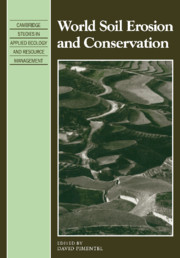Book contents
- Frontmatter
- Contents
- List of contributors
- Foreword
- Overview
- 1 Soil erosion and conservation in West Africa
- 2 Land degradation, famine, and land resource scenarios in Ethiopia
- 3 Soil erosion and conservation in China
- 4 A case study in Dingxi County, Gansu Province, China
- 5 Soil erosion and conservation in India (status and policies)
- 6 Soil erosion and conservation in Australia
- 7 Soil erosion and conservation in Argentina
- 8 Soil erosion and conservation in the United Kingdom
- 9 Soil erosion and conservation in Poland
- 10 Soil erosion and conservation in the humid tropics
- 11 The management of world soil resources for sustainable agricultural production
- 12 Soil erosion and agricultural productivity
- 13 Vetiver grass for soil and water conservation: prospects and problems
- References
- Index
- Frontmatter
- Contents
- List of contributors
- Foreword
- Overview
- 1 Soil erosion and conservation in West Africa
- 2 Land degradation, famine, and land resource scenarios in Ethiopia
- 3 Soil erosion and conservation in China
- 4 A case study in Dingxi County, Gansu Province, China
- 5 Soil erosion and conservation in India (status and policies)
- 6 Soil erosion and conservation in Australia
- 7 Soil erosion and conservation in Argentina
- 8 Soil erosion and conservation in the United Kingdom
- 9 Soil erosion and conservation in Poland
- 10 Soil erosion and conservation in the humid tropics
- 11 The management of world soil resources for sustainable agricultural production
- 12 Soil erosion and agricultural productivity
- 13 Vetiver grass for soil and water conservation: prospects and problems
- References
- Index
Summary
Soil is one of the most fundamental resources we have. For some years, reports have told of its alarming degradation by erosion and salinization. As long ago as 1984, one report argued that at current rates of loss, topsoil reserves would disappear in about 150 years, a few decades after the exhaustion of the planet's recoverable oil reserves. Yet these warnings have had little impact. The public has clamoured for action to plug the ozone hole over Antarctica, stop acid rain, halt the greenhouse effect and save the forests – yet little has been said about the soil loss that could destroy the hopes of a stable and fruitful earth a century from now.
Action, if it is to be sound, needs to be based on facts. There has been a shortage of them regarding the scale, regional pattern, rates and causes of soil loss – and possible remedial measures. This book is a contribution to filling that gap. Professor Pimentel, its editor, is a world-famous ecological scientist and he has assembled a team of distinguished collaborators. Chapter by chapter they review the situation around the world. At the outset, the editor reminds us that some 30–50% of the earth's land surface is affected by soil degeneration. In West Africa, low crop yields are due partly to severe past erosion and reduced fertility. Recent famines in Ethiopia are described not as natural disasters, but as cultural catastrophes following natural events, in a country which, given wise management and environmental restoration, has the capacity to be self-sufficient and sustainable within the next 50 years.
- Type
- Chapter
- Information
- World Soil Erosion and Conservation , pp. xi - xiiPublisher: Cambridge University PressPrint publication year: 1993

